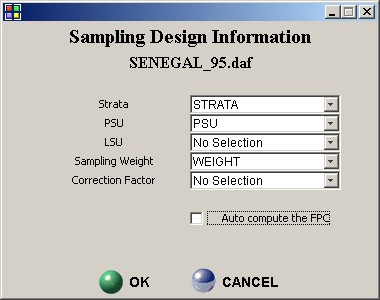|
Exercise 10.3 |
|
When sample observations represent households, three size variables can be used in
combination with the variable of interest EXPEQ:
-
1 for all households
-
The number of persons in the household (SIZE)
-
The number of adult equivalents in the household (EQUI)
Compute the FGT index for a
= 0,1 for every one of these three alternative definitions of the size variable and explain the difference. |
|
Answer |
|
STEP
1:
Initialising the sampling weight: EDIT|Set
Sample Design |
|

|
|
STEP
2: Use the DAD Application:
POVERTY|FGT INDEX |

|
RESULTS |
FGT (Poverty)
| Session Date |
Tue Sep 14 13:45:25 EDT 2004 |
| Execution Time |
0.0 sec |
| FileName |
SENEGAL_95.daf |
| OBS |
2447 |
| Sampling Weight |
WEIGHT |
| Variable of interest |
EXPEQ |
| Size variable |
Without size |
| Group variable |
No Selection |
| Group Number |
1 |
| Option |
Normalised = YES |
| Parameter |
α=0 |
Index |
Estimated value |
Standard deviation |
Lower bound |
Upper bound |
Confidence Level in (%) |
FGT |
0.62478000 |
0.01641005 |
0.59261689 |
0.65694311 |
95.00000000 |
Poverty line |
140000.00000000 |
0.00000000 |
140000.00000000 |
140000.00000000 |
95.00000000 |
EDE |
0.00000000 |
0.00000000 |
0.00000000 |
0.00000000 |
95.00000000 |
| |
Headcount |
Poverty gap |
| Without size |
0.6248 |
0.2374 |
| SIZE |
0.6677 |
0.2613 |
| EQUI |
0.6652 |
0.2598 |
|
|

